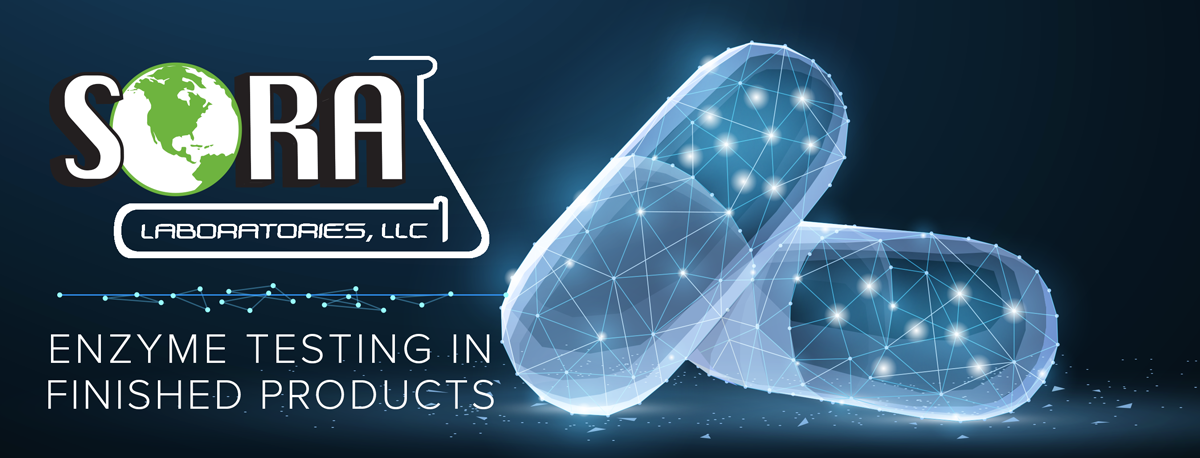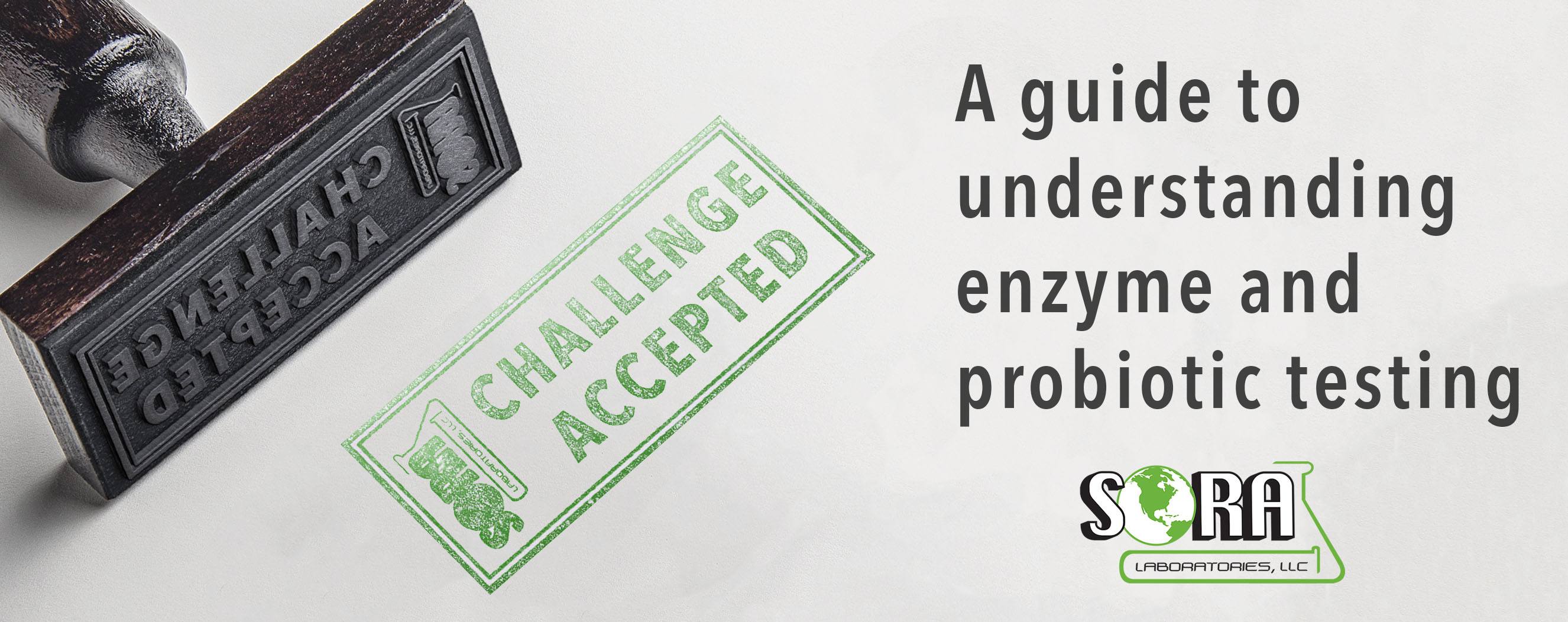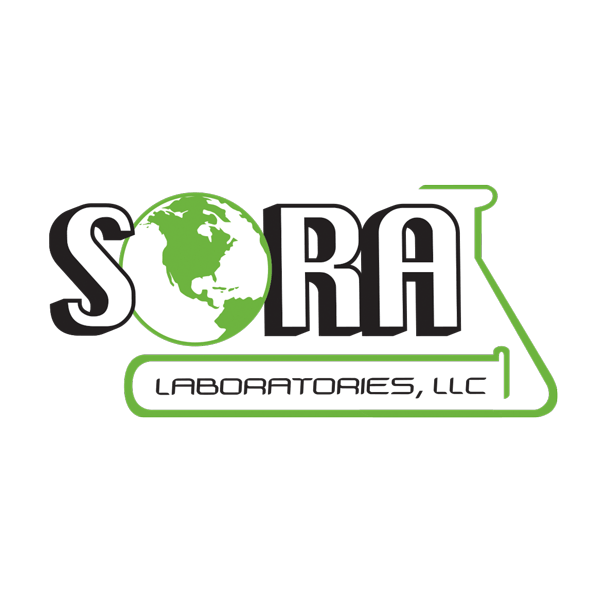SORA Labs has been testing enzyme activity assays and probiotic enumeration for more than 30 years. In fact, we were the first lab to add enzyme activity assays to an ISO/ICE 17025:2015 scope of accreditation in the U.S. Most of the methods we use come from the USP/FCC, BP, JP and other compendia, which are designed for raw material testing. One question we hear frequently is if it’s possible to test enzyme activities in finished products containing an enzyme blend. The answer is YES! We can test enzymes in finished products, however, like most analyses, it’s not as straight forward as raw material testing. Based on these experiences, we have put together a list of common interferences seen with finished product enzyme testing.
1) Combined Protease Effect: This occurs when several proteases are mixed together in a single blend. The protease activity of each enzyme is magnified by synergistic effects and boosts the protease activity. Enzymes are standardized to a single activity but may have other non-standardized activities present. These non-standardized activities are called side activities and can cause the proteases to show higher than expected results.
2)Enzyme/Carbohydrate Interference: The most common observation of this phenomena is with lactase but can be seen with other enzymes also. Lactase results often fall below label claims because of carbohydrates in the blend.
3) pH Co-Ingredient Interference: Enzyme activity assays are pH and temperature- controlled reactions. When the assay conditions are altered, the reaction may be affected, and the method may not perform correctly. Ingredients like betaine HCl, lemongrass, calcium carbonate, ox bile, and other high or low pH ingredients may swing the pH of the reaction solution outside the ideal method pH. Sometimes adjustments can be made to allow the reaction to run, but this is not always the case.
4) UV Co-Ingredient Interference: Many enzyme activity assays have a UV-Vis endpoint. If botanicals or other chemical ingredients are included in the enzyme matrix finished product, these ingredients may cause UV interferences. Methods that look for a change in UV absorbance could show inaccurate readings if these co-ingredients have similar UV characteristics.
Providing as much information about your product before testing begins will help determine possible interfering ingredients. When a testing lab is an extension of your team, you have a tremendous asset, because all these interference scenarios can be proven with testing.
We often use small sized, formulation-specific, lab blends, which allow us to remove the interfering ingredient(s) and then test the activity again. If the recovery is improved and the results meet label claims, then the product interference is confirmed.
We can also perform spike studies and measure the recovery of a known enzyme spike. Adding a known amount of enzyme into the finished blend and then testing for activity, will help determine the interference. When only partial recovery of the spike is observed, then this shows that there is interference with the testing.
Getting the blend testing and interferences figured out at the product development stage is very important to preventing product delays later in the process. Once products are ready to be shipped, then it is often a stressful scramble to understand why label claims are not being met. SORA Labs is here to help! Let us test your products so you can understand any interferences that are present. Remember, understanding your product’s unique characteristics early on, will help set the stage for successful manufacturing and sales.
Trusted testing services—the team approach
For ingredient suppliers, contract manufacturers and brand owners, partnership with a testing lab is often a necessary component. Even with an in-house lab, a company may not be able to perform every test required for their products due to the extensive nature of various testing practices and methods. When complicated, cost prohibitive, or specialty methods are required, partnership with an experienced testing lab, makes perfect sense—enter specialty 3rd party testing labs like SORA Labs.
The FDA Code of Federal Regulations requires that a vendor be qualified, and just like any other vendor, labs should be questioned about the expertise of methods they run. Reviewing proficiency testing; requesting staff qualification and reviewing standard operating procedures (SOP), can provide valuable insight when evaluating a lab. Ultimately, an on-site audit is the best strategy when making a final determination of a lab’s worthiness. Another qualifier when choosing a lab is the ISO 17025:2005 accreditation from the International Organization of Standardization. This signifies that the lab has met stringent criteria and passed audits to be considered a high quality international testing lab.
A lab partnership should also include a Quality Agreement (QA), which defines responsibilities, methods, out-of-specification communication and more. As regulations are increasing, the industry continues to see more findings regarding quality control procedures. An in-place agreement will ensure the quality process has been defined for outsourced testing, and both companies understand each other’s roles and expectations. If a Quality Agreement has not yet been established, you can find our QA form here (Quality Agreement Form Request). Since ISO already requires the highest level of confidentiality, a Non-Disclosure Agreement (NDA) is less important than the Quality Agreement; however some companies choose to have both agreements in place.
Although you may not need outside testing services on a daily basis, it’s a smart idea to have a qualified and experienced lab in your corner when the need arises. Sometimes, it can take a team to get your project completed and partnering with a high-quality testing lab like SORA Labs, is a great place to start. Let us help you today!
Challenge accepted . . . A guide to understanding enzyme and probiotic testing
Similarities between enzyme activity assays and probiotic enumeration are more common than most people realize. Both methods of testing require many dilutions, multiple calculations and are technique-driven. Our lab performs the probiotic colony forming unit (CFU) assays in our microbiology lab, and enzyme activities are tested in our chemistry lab. Both probiotics and enzymes aid in digestion and have potency that cannot be measured by weight or mg. Instead, probiotics are measured by CFUs and enzymes are measured in various activity units, with both having a variety of assay methods available. The ingredient supplier will often have a specific method for their product, and there may also be compendial methods listed in the Food Chemical Codex (FCC). While probiotic suppliers have not started standardizing to the compendial methods as of yet, enzyme ingredient suppliers use the FCC methods to standardize their products, for the most part. As time goes on, the probiotic industry may start standardizing to similar methods like the enzyme industry.
Both probiotic enumeration and enzyme activity assays listed in the FCC, are designed for raw material ingredients. Ideally, these assays should be performed on an ingredient before it is blended with other ingredients or encapsulated as a finished product. When multiple enzymes or probiotic strains are blended together, the testing becomes more difficult. There are common interferences with blended enzymes products, and also challenges with the multiple probiotic blends. Since each blend is unique and will interact in its own way, testing them can be tricky. However, it is possible to have successful results and gain valuable data about your product when tested correctly.
But, just as there are many similarities, there are also differences. Probiotic strains are living organisms, where enzymes are not. Instead, enzymes are ingredients, which break down food, whereas probiotics add to our gut flora for various health benefits. Lastly, enzyme activity is measured by substrate breakdown, instead of plate growth which measures probiotics.
Ultimately, both have complex test methods and require a high level of expertise and years of practice to perform accurately. SORA Labs is your trusted partner for both enzyme and probiotic With developed methods, we can help you learn more about your product through Testing is the only valid method to prove the quality of your product, so choosing an experienced lab is a must. Call us today for a quote!
Taking the Mystery out of Enzyme Blends
Enzyme blends are complicated to understand, but appropriate testing can help solve the mystery that is often associated with these. There are several recommended tests for enzyme products that are identified by Good Manufacturing Practices (GMPs). These include: identity, potency, contamination and/or adulteration
It is possible to identify enzymes in a blend with mini-assays for many of the common enzymes on the market. These ID tests are not FTIR fingerprint tests, but instead show that the enzyme is still working and has not been deactivated by heat or humidity. If the enzyme in the blend does not have this wet chemistry identity test available, then the full potency assay could be completed with the ID listed as “positive per assay.”
For enzyme potency claims, most manufacturers measure enzyme activity units, “by input.” This is applicable because enzymes have interactions that are unique to each blend. When trying to follow GMP’s and FDA regulations, it’s important to test your finished products to meet all label claims. Testing of the blend is possible, but your results may differ from the “input” activities on the label because by definition, enzymes are proteins that act as catalyst for biochemical reactions. Testing the blends is the only way to fully understand these interactions. Some of the common interactions can be read here.
Since contamination can come from several sources, it is recommended to test enzyme products for common culprits such as heavy metal or microbial contamination. Heavy metal contamination could be introduced with tainted water that is used in the fermentation process or with carriers used in the drying process. Microbial contamination may come from improper handling, dirty equipment or other surfaces that have not been cleaned properly that the material touches.
Product adulteration, often the result of supplier mistakes or dishonest practices, may be difficult to identify. Research should be done to determine if there are any known adulterants for that specific material. While it’s impossible to test for every adulterant known for each ingredient, we can certainly test for specific ones that have been found to be an issue in the past. One known adulterant affecting the enzyme market is chloramphenicol. Chloramphenicol is an antibiotic that was used overseas to clean equipment or control microbial growth and consequently became a residue in finished material. With chloramphenicol being a known issue, material screening can effectively identify the presence of chloramphenicol residue. SORA Labs developed an in-house validated chloramphenicol testing method based on the FDA LIB4306. This in-house method specifically detects chloramphenicol in the enzyme matrix using the HPLC MS/MS. A proud accomplishment, SORA was recognized at the NA Residue Conference for outstanding development. More information on chloramphenicol testing can be found here.
Enzyme blends are complex, but choosing the right testing lab will go a long way in demystifying what testing is needed to ensure your products are safe and of the highest quality. SORA Labs has the enzyme expertise with this matrix and many other enzyme activity methods on their ISO 17025:2005 scope of accreditation. Let SORA Labs solve your enzyme testing mystery today!




